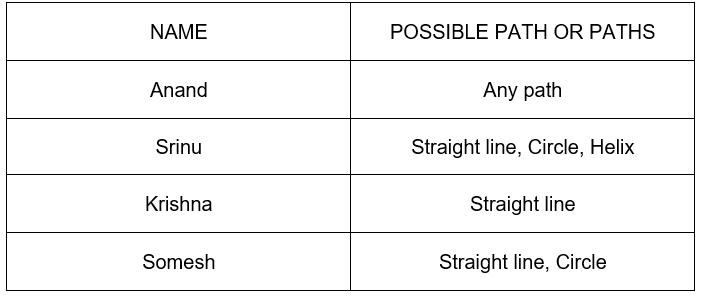
Four students discuss the possible paths of a particle moving with a constant speed. See the table for the results of the discussion.

Who is correct? Assume that the forces acting on the particle are time-independent.
A) Srinu
B) Anand
C) Somesh
D) Krishna

Answer
557.4k+ views
Hint: We need to understand the correct interpretation of constant speed to analyze the dependence of the path on the speed parameter. We need to carefully study the different paths and their particular properties exhibited by a body during motion.
Complete step-by-step solution
We know that different types of motion exhibited by a body can result in different parameters of motion. In common terms, a body undergoing a circular motion will have a zero displacement after one complete circular motion, whereas a body that goes along a straight line will keep on increasing the displacement throughout its motion.
Similarly, the speed and velocity of a particle undergoing a motion are dependent on the type of motion the body undertakes. The speed of a body is the rate of change of distance of the body with respect to time. It is a scalar quantity and is devoid of any sense of direction. The velocity of a body is the rate of change of displacement of the body, which is a vector quantity and the direction plays an important role.
We are given three paths – straight line, circular and helical. From the definition of speed, we understand that it is independent of the direction in which the body moves. So, a body undergoing a circular motion changes its direction at every instant but the magnitude of the velocity or simply the speed of the motion is a constant. This same is applicable for the helical motion also. In the straight-line motion, there exists no direction change at all.
So, we can conclude that a body can undergo a constant speed in a straight line, circular and helical motion.
The correct answer is option A.
Note: The displacement of a body is a vector quantity and therefore the rate of change of displacement or the velocity is also a vector quantity. The speed, whereas, is the rate of change of distance, which is a scalar, so the speed is also a scalar quantity.
Complete step-by-step solution
We know that different types of motion exhibited by a body can result in different parameters of motion. In common terms, a body undergoing a circular motion will have a zero displacement after one complete circular motion, whereas a body that goes along a straight line will keep on increasing the displacement throughout its motion.
Similarly, the speed and velocity of a particle undergoing a motion are dependent on the type of motion the body undertakes. The speed of a body is the rate of change of distance of the body with respect to time. It is a scalar quantity and is devoid of any sense of direction. The velocity of a body is the rate of change of displacement of the body, which is a vector quantity and the direction plays an important role.
We are given three paths – straight line, circular and helical. From the definition of speed, we understand that it is independent of the direction in which the body moves. So, a body undergoing a circular motion changes its direction at every instant but the magnitude of the velocity or simply the speed of the motion is a constant. This same is applicable for the helical motion also. In the straight-line motion, there exists no direction change at all.
So, we can conclude that a body can undergo a constant speed in a straight line, circular and helical motion.
The correct answer is option A.
Note: The displacement of a body is a vector quantity and therefore the rate of change of displacement or the velocity is also a vector quantity. The speed, whereas, is the rate of change of distance, which is a scalar, so the speed is also a scalar quantity.
Recently Updated Pages
Master Class 8 Maths: Engaging Questions & Answers for Success

Class 8 Question and Answer - Your Ultimate Solutions Guide

Master Class 12 Economics: Engaging Questions & Answers for Success

Master Class 12 Maths: Engaging Questions & Answers for Success

Master Class 12 Biology: Engaging Questions & Answers for Success

Master Class 12 Physics: Engaging Questions & Answers for Success

Trending doubts
Which one of the following groups comprises states class 8 social science CBSE

A couple went for a picnic They have 5 sons and each class 8 maths CBSE

Advantages and disadvantages of science

Write a letter to the Municipal Commissioner to inform class 8 english CBSE

What are the methods of reducing friction. Explain

Differentiate between the farms in India and the U class 8 social science CBSE





